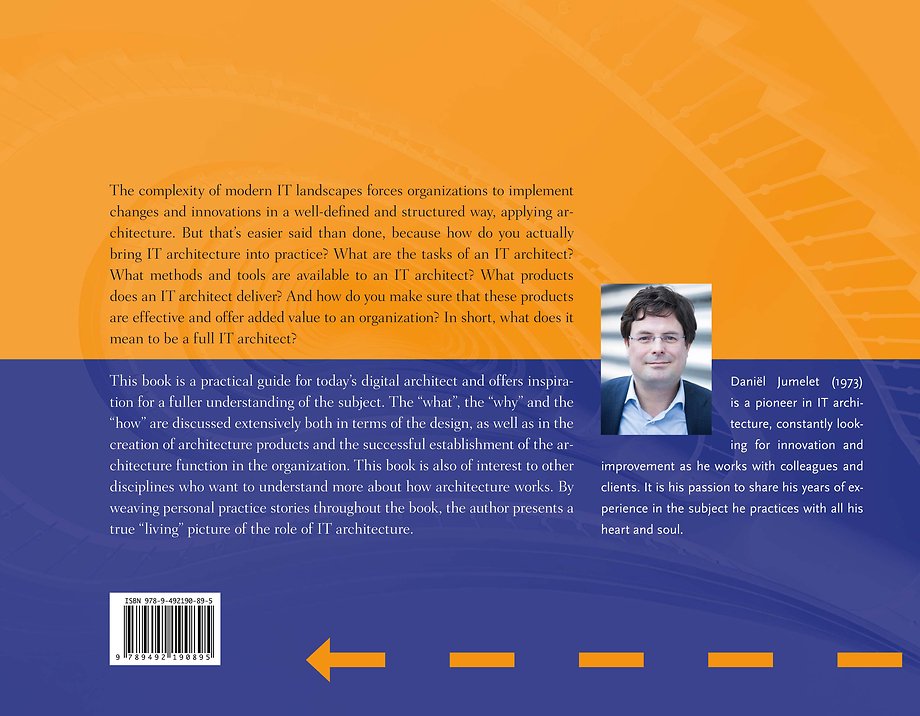



Daniël Jumelet (1973) is sinds 1994 werkzaam in de IT. Sinds 2005 doet hij onderzoek in de praktijk naar de toepassing van architectuur op infrastructuur.
Meer over Daniël JumeletBringing IT Architecture to life
Real world application of a function-oriented approach
E-book Epub met watermerkbeveiliging Engels 2018 1e druk 9789492190901Samenvatting
The complexity of modern IT landscapes forces organizations to implement changes and innovations in a well-defined and structured way, applying architecture. But that’s easier said than done, because how do you actually bring IT architecture into practice? What are the tasks of an IT architect? What methods and tools are available to an IT architect? What products does an IT architect deliver? And how do you make sure that these products are effective and offer added value to an organization? In short, what does it mean to be a full IT architect?
This book is a practical guide for today’s digital architect and offers inspiration for a fuller understanding of the subject. The “what”, the “why” and the “how” are discussed extensively both in terms of the design, as well as in the creation of architecture products and the successful establishment of the architecture function in the organization.
This book is also of interest to other disciplines who want to understand more about how architecture works. By weaving personal practice stories throughout the book, the author presents a true “living” picture of the role of IT architecture.
Trefwoorden
Specificaties
Lezersrecensies
Inhoudsopgave
Preface
Chapter 1 Introduction
1.1 Major tasks of an IT architect
1.2 The insights and skills of the IT architect: how to read this book
1.3 The main messages of this book
Personal practical stories
A few asides
Chapter 2 The role of architecture in the development process
2.1 Phases of the design: the development sequences
2.2 In detail: steps in the architecture continuum
2.3 Involvement of stakeholders
The role of the community
Chapter 3 The making of function models: the heart of architecture
3.1 Patterns
3.2 A lexicon for infrastructure functions
3.3 ArchiMate: a semantic for the modeler
3.4 Application of the OIAm model approach outside of the infrastructure domain
Handling data center transitions
Chapter 4 Working with models: examples
4.1 Example 1: The Exchange migration
4.2 Example 2: Identity Management for cloud solutions
Design of workplace services
Chapter 5 Ingredients of architecture products
5.1 User stories
5.2 Service descriptions
5.3 Quality aspects
5.4 Environments
5.5 User categories5.6 Principles5.7 Architecture Building Blocks
5.10 Threat analyses
Working on Architecture repositories
Chapter 6 Architectural products
6.1 Organization Context Analysis (OCA)
6.2 Business-IT plan, roadmap and project calendar
6.3 Architecture repository
6.4 Business case / impact analysis / feasibility study
6.5 Project Start Architecture (PSA), Sourcing Start Architecture (SSA) and Solution Foundation
6.6 Root cause analysis
Functional tenders
Chapter 7 Embedding architecture
7.1 Goals
7.2 Processes
7.3 Roles
7.4 Architecture products
7.5 Strategic partners
7.6 Governance
7.7 Making architecture visible
Office politics: decision support
Chapter 8 Infrastructure architecture and IT security
8.1 Strategy determination
8.2 Threats and risk analysis
8.3 Mitigation8.4 Example of a threat analysis
8.5 Security Management
8.6 Privacy protection
Coping with trends
Appendix A Introduction to OIAm
A.1 What is OIAm?
A.2 The focus of OIAm
A.3 What does OIAm offer?
A.4 History of OIAm
A.5 What remains outside the scope for OIAm?
Appendix B Modeling protocols for the application of ArchiMate
B.1 The use of ArchiMate
B.2 Preferred concepts in infrastructure
B.3 Relationship conventions
B.4 Relationships between views and layers
Appendix C Cloud Service Packages
C.1 Application Hosting
C.2 Web Hosting
C.3 Calculation
C.4 Data Management
Glossary
References
Vergelijkbare boeken
Anderen die dit e-book kochten, kochten ook
Rubrieken
- advisering
- algemeen management
- coaching en trainen
- communicatie en media
- economie
- financieel management
- inkoop en logistiek
- internet en social media
- it-management / ict
- juridisch
- leiderschap
- marketing
- mens en maatschappij
- non-profit
- ondernemen
- organisatiekunde
- personal finance
- personeelsmanagement
- persoonlijke effectiviteit
- projectmanagement
- psychologie
- reclame en verkoop
- strategisch management
- verandermanagement
- werk en loopbaan









